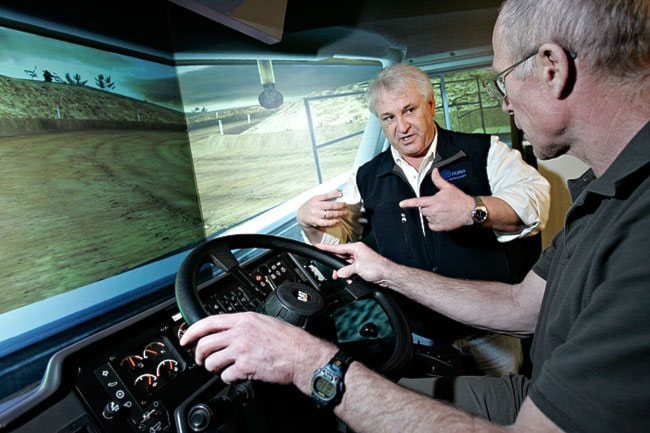In an open pit mine somewhere in Canada, the driver of a 777D earthmover is casually delivering his load of newly excavated rock.
Suddenly, the engine erupts into flames.
Calmly, the operator cuts the engine, brings the earthmover to a stop, calls his supervisor and exits the vehicle to safety.
At the push of a button, the fire is magically extinguished and the training is complete.
Back in the old days, all heavy equipment training was on the job. Which was fine, unless something went wrong.
“You can’t start a fire on a multi-million-dollar machine and show them how to compensate for that,” said Tracy Thomas, executive director of the Yukon Mine Training Association.
On Thursday, 20 association students completed training on a heavy equipment simulator brought up by Nuna Training Technologies.
Three high-resolution screens surround a chair mounted on hydraulics programmed to vibrate and shift in concert with the movements of the virtual truck. Operating a set of flawlessly replicated controls, the student manoeuvers through a stunningly accurate computer-generated minesite.
Friday, the public was invited to operate the virtual rock hauler during an open house.
Driving too quickly down a shallow grade, it seems, sends engine revolutions into the red zone. Suddenly, the chair shudders, the screen shakes and the virtual truck grinds to a stop.
“You just seized the engine, that’s, like, $250,000,” said instructor Glenn Jones.
Before pulling away, you always need to honk the horn, he said.
“One time, back in 1980, I looked all around my truck - couldn’t see a thing. But then I honked and a guy came flying out from underneath - could have been a really bad situation if I hadn’t honked.”
Jones’ story of a friend being killed in a mining truck accident quickly quenches any urge to purposely crash the virtual truck.
“You don’t have to be afraid of these things, but you’ve got to respect them,” he said.
NUNA instructors can take the brakes away, take the steering away or even leave service roads strewn with rocks and discarded construction equipment in heavy fog.
Or, the simulator can adjust the behaviours of other vehicles and heavy equipment on the worksite, turning the mine into a treacherous labyrinth of swerving pickups and haywire front-end loaders.
Students run their virtual heavy equipment through a generic open minesite. However, mining companies looking for a little extra realism can program the exact co-ordinates of their particular mine into the simulator.
The entire simulator is housed within a monolithic white shipping container.
It’s surprisingly portable. Wherever you are, NUNA will get a simulator to your mine to train employees onsite, the company promises.
It’s a credo that has seen the simulator schlepped across Canada.
“It’s ridden on a boat, it’s ridden on a truck and we even loaded it onto a C-130 Hercules aircraft,” said NUNA training superintendent Bob Huculak.
Rows of stickers at the entrance to the simulator detail the myriad of mining companies it has visited, resembling the guitar case of a touring musician gigging at far-flung northern mines.
The going rate for NUNA’s made-in-Australia training simulator is $750,000.
A 20-day session comes in at $50,000. With eight students graduating, simulator training averages out to $6,250 per student.
The training is funded by the Target Investment Program, administered by Indian and Northern Affairs Canada
For every additional 20-day session, prices go down, said Thomas.
Heavy equipment operation is nearly as versatile a trade as carpentry, especially in the North.
“These are really transferable skills - a truck is a truck is a truck,” said Thomas.
“They could end up in a mine, they could end up in construction, they could end up in oil and gas,” she said.
With NUNA graduates, employers reap the benefit of a safety conscious operator, which affects the overall safety culture of a worksite, said recent NUNA graduate Peter Wylie, dubbed “Wylie Coyote” by coworkers.
“It opens more doors - companies don’t want to train you, they’d rather just hire you,” said fellow graduate Shelly Hunlin.
Among many northern mines, NUNA training has become an essential financial and safety investment.
In the simulator, a new operator cannot inflict “training-equipment damage,” notes the NUNA information pamphlet.
And when equipment suddenly bursts into flames or veers out of control, an employee’s few thousand dollars worth of NUNA training can mean the difference between a minor worksite incident and a financial and human tragedy.
For the past four years, NUNA has made twice-yearly visits to an undisclosed northern mine to brush up the skills of new and experienced employees.
“Their value is based on safety and cost,” said Huculak.
Across the board, digital simulation is making industry safer.
A South African company recently completed a welding simulator. The students don a virtual reality helmet, grasp virtual welding tools and learn their trade in the emission-free, burn-free safety of cyberspace.
“Star Wars, that’s what it is,” said Huculak.
Portability is a major factor in virtualizing industrial trades, such as welding, especially for northern communities, said Huculak.
“You don’t have to load up thousands of pounds of equipment to go out and see if individuals really want to take welding,” he said.
The Playstation has given us virtual rock stars, virtual carjackers and virtual soldiers. Industry has only gotten started - and its stakes are much higher. With more than 1,000 workplace fatalities per year, simulation may be a way to save lives.
“I’ve been in this racket for 15 years, and for me, the future is in simulation for entry level training - that’s where it’s gonna go,” said Huculak.
Contact Tristin Hopper at
tristinh@yukon-news.com
